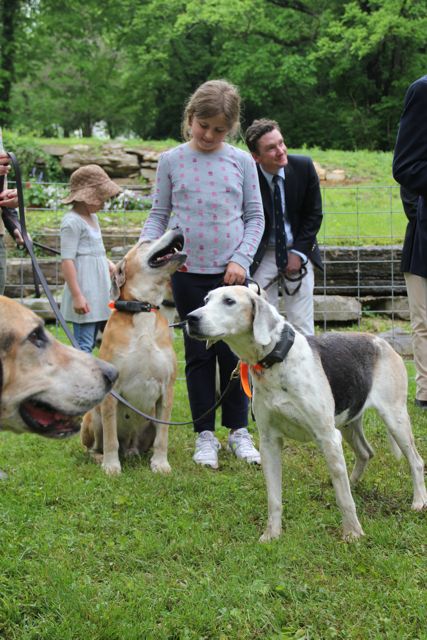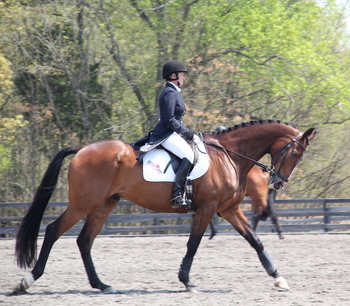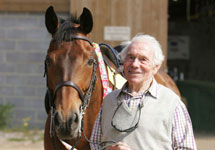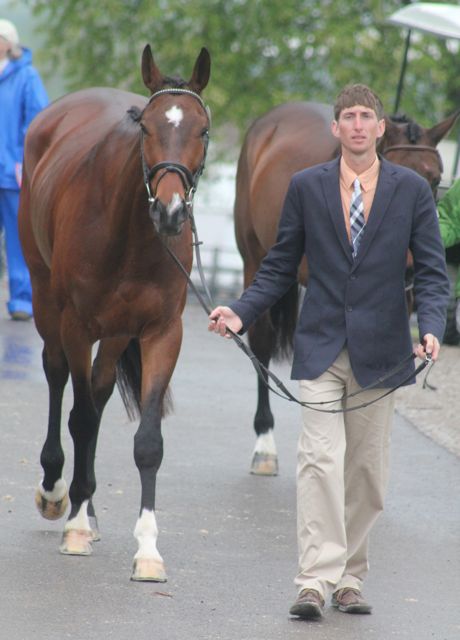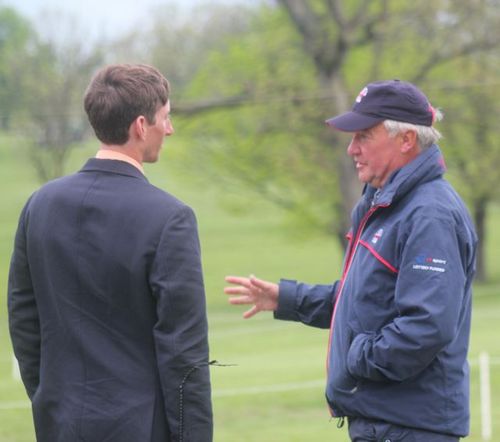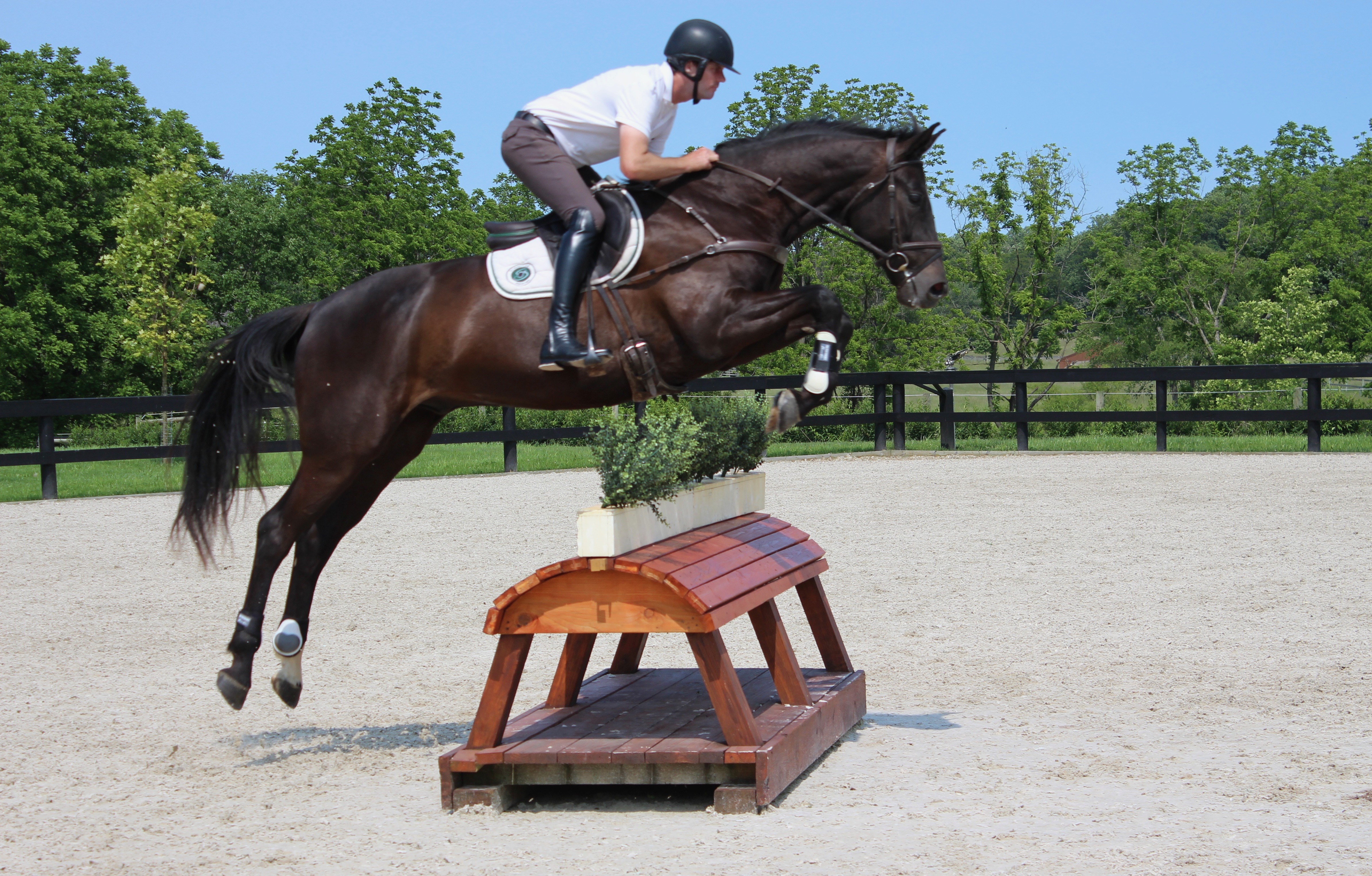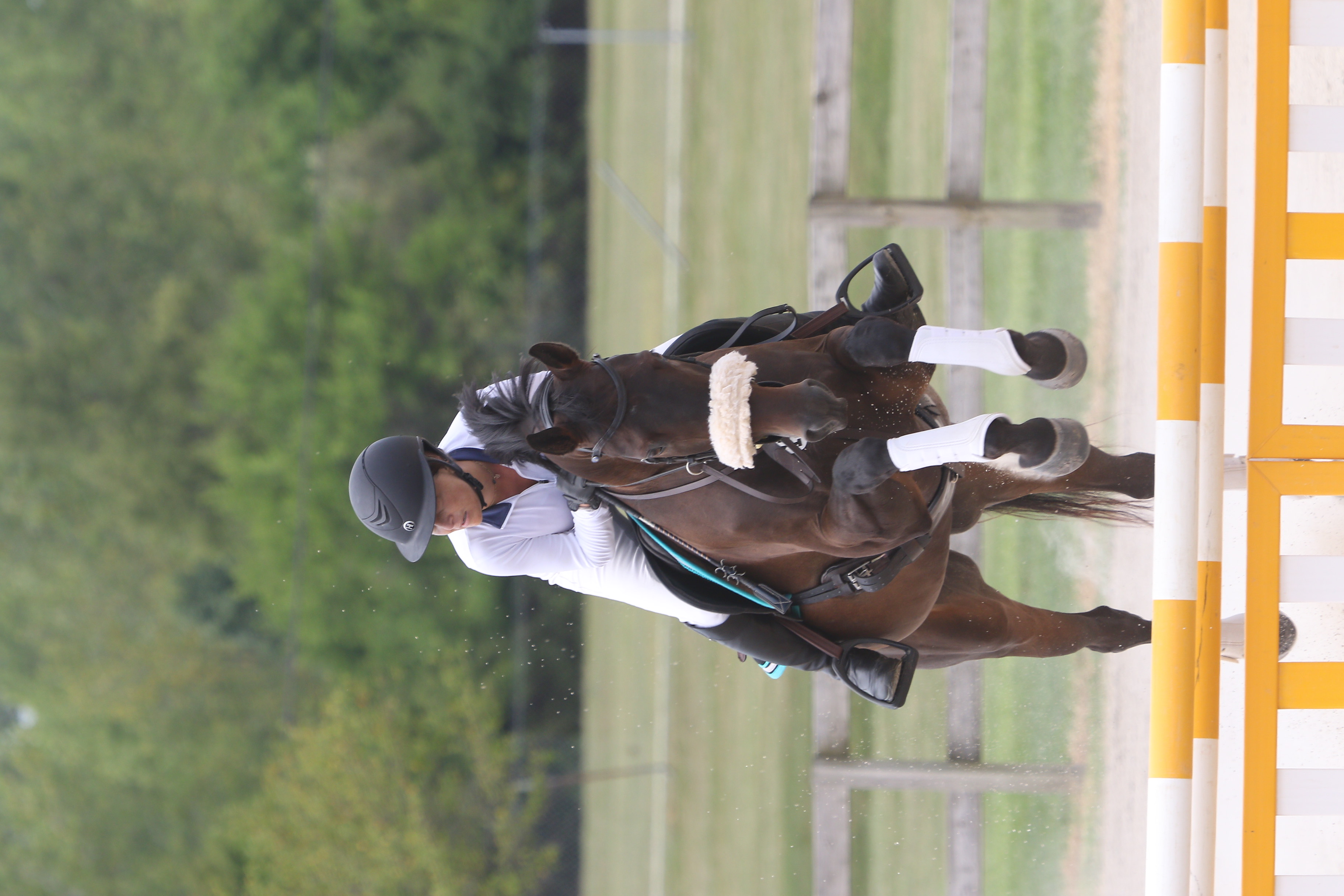Jim Koford caught the eye of many last year when he received the $25,000 Anne L. Barlow Ramsay Annual Grant from The Dressage Foundation to train in Europe. On his return he duly won the finale of the Dressage Under the Stars Series in Wellington, Florida, dressed as Batman, which garnered even more press and attention! His lovely horse Robin Rhett, belongs to Versailles, KY based equine chiropractor Shirley McQuillan so he’s been based here in Lexington for a couple of months, and when my eventing friends started raving about him, and driving from as far afield as Louisville to take lessons with him, that’s when I sat up took notice too.
Samantha Clark
Achievements
 Become an Eventing Nation Blogger
Become an Eventing Nation BloggerAbout Samantha Clark
Latest Articles Written
Schooling at the horse park
Iroquois Hound & Puppy Show
A very generous, and last-minute invitation saturday afternoon saw us at the Iroquois Hunt Club, feeling decidedly underdressed, at their inaugural Hound and Puppy Show, a prep for the “big one” in a a couple of weeks time in Middleburg, Virginia. Hound and puppy shows are quite popular in England, sometimes as part of the county shows and horse shows, sometimes they stand alone, and as soon as I saw the refreshments I felt right at home!
No Rain (was not playing today)
High hopes for High Hopes
Next Sunday, May 22nd, will see a happy return to the Kentucky Horse park for the 44th running of the High Hope Steeplechase after a year’s hiatus because of the World Equestrian Games.
This article is also published on SamanthaLClark.com
High hopes for High Hopes
Next Sunday, May 22nd, will see a happy return to the Kentucky Horse park for the 44th running of the High Hope Steeplechase after a year’s hiatus because of the World Equestrian Games.
Keeping your head
At the beginning of the year, Riders4Helmets organised a safety symposium down in Wellington, Florida which brought together not only many experts within different disciplines of horse sports, (racing, polo, jumping, eventing, dressage…) but also David O Connor and John Long representing the USEF, helmet manufacturers, and two esteemed experts in brain injuries and trauma: Dr. Allen Sills from the Sports Concussion Center at Vanderbilt University, and Dr. Craig Ferrell, the FEI medical Chairman and US team physician. This may have been the first time in the world that such a diverse group of horsemen and women met in one room with one common goal – rider safety; and the results are ongoing and impressive.
Keeping your head
At the beginning of the year, Riders4Helmets organised a safety symposium down in Wellington, Florida which brought together not only many experts within different disciplines of horse sports, (racing, polo, jumping, eventing, dressage…) but also David O Connor and John Long representing the USEF, helmet manufacturers, and two esteemed experts in brain injuries and trauma: Dr. Allen Sills from the Sports Concussion Center at Vanderbilt University, and Dr. Craig Ferrell, the FEI medical Chairman and US team physician. This may have been the first time in the world that such a diverse group of horsemen and women met in one room with one common goal – rider safety; and the results are ongoing and impressive.
Remembering Sam Barr and the Welton Dynasty with Leslie Law
I read with sadness of Sam Barr’s passing last weekend. He was truly a pioneer of event horse breeding in England, and for me, the Welton name will also always be synonymous with Leslie Law. Although I was extremely young (!), I do remember Leslie riding Welton Apollo at Badminton, three years in a row, and representing GB at Burghley. That was the start of Leslie riding a number of the Welton horses, and although both our memories are a bit fuzzy, we had a nice chat about the good old days!
Remembering Sam Barr and the Welton Dynasty with Leslie Law
I read with sadness of Sam Barr’s passing last weekend. He was truly a pioneer of event horse breeding in England, and for me, the Welton name will also always be synonymous with Leslie Law. Although I was extremely young (!), I do remember Leslie riding Welton Apollo at Badminton, three years in a row, and representing GB at Burghley. That was the start of Leslie riding a number of the Welton horses, and although both our memories are a bit fuzzy, we had a nice chat about the good old days!
Studs with Emma Ford
A reader asked if we could ask one of the riders which studs they used Saturday at Rolex, and about studs in general. I got really lucky and went one better, and I’m delighted to present a masterclass on studs with none other than Emma Ford, head girl to Phillip Dutton at True Prospect Farm – anything she doesn’t know isn’t worth knowing!
Studs with Emma Ford
A reader asked if we could ask one of the riders which studs they used Saturday at Rolex, and about studs in general. I got really lucky at Rolex and went one better, and I’m delighted to present a masterclass on studs with none other than Emma Ford, head girl to Phillip Dutton at True Prospect Farm – anything she doesn’t know isn’t worth knowing!
Greatness and Goodness: Barbaro and his legacy
I’m so glad that I was able to post this interview just in the nick of time, with a) the Kentucky Derby on saturday, and b) Mother’s Day on Sunday, because Alex Brown’s book, Greatness and Goodness: Barbaro and his Legacy will make the perfect accompaniment for both. For trivia fans, it’s the five year anniversary of Barbaro’s Ky Derby win on Saturday.
This article is also published on SamanthaLClark.com
Greatness and Goodness: Barbaro and his legacy
I’m so glad that I was able to post this interview just in the nick of time, with a) the Kentucky Derby on saturday, and b) Mother’s Day on Sunday, because Alex Brown’s book, Greatness and Goodness: Barbaro and his Legacy will make the perfect accompaniment for both. For trivia fans, it’s the five year anniversary of Barbaro’s Ky Derby win on saturday.
Gosh, I hate Goodbyes
Goodbye USA
Dear Eventing Nation,
I’m writing this at 32,000 feet, somewhere above that large expanse of the USA that lies between Lexington and the West Coast. Wherever we are I know that we’re not circling around Kentucky because the sun is shining, the skies are clear and there’s no imminent danger of being swept up by a tornado and dropped in Ohio. I’m almost sad to say it but for the first time in nearly three weeks the weather is not that interesting.
I’ve been in the USA for 21 days. I arrived on a cargo flight in a business class seat with four bags of gear, two saddles, a suitcase and a horse. I’m headed back to Australia with just the suitcase in a cramped economy seat, and instead of a horse I’m sitting next to a guy who’s stolen my armrest and is eating his tuna-salad foot-long with such intensity that he may well be single-handedly responsible for the over-fishing in the world’s oceans. I can only imagine how Mary King is traveling but I strongly doubt whether she is fighting a territorial battle with a fish as she returns to Mother England.
It didn’t seem right to leave the USA without saying a proper goodbye. The three weeks I’ve had in Kentucky have been some of the best of my life. Flying Tiger over to compete at Rolex was a complex, expensive and some might say crazy undertaking. While this whole trip has had its ups and downs, I’ll remember it as a huge and exhilarating adventure. I’ve ridden at one of the biggest and best events in the world, and I’m proud of my horse, my coach-partner-groom Annabel (Bols), and my family. And even though it might not be reflected on the scoreboard, I’m even a little bit proud of the way I rode. The lessons that you learn in a week at an event like Rolex can take years to learn in your own backyard. Unlike Mary I’m not taking home a Rolex watch, an enormous trophy or enough cash to buy a small farm, but I am exporting a wealth of experience and in the end that’s far easier to get through airport security.
I can’t say enough how appreciative we’ve been for the hospitality, support and friendship shown to us by the riders, organisers, equestrian media and the general eventing public while we were in Kentucky. Not once did we feel out of place, unwelcome or foreign. Christina Gray, chief organizer of the Rolex event is a champion who went well out of her way to make us feel at home at a time when she had far bigger fish to fry. The same can be said about Samantha Clark of EN fame who supplied enough groceries when I arrived for me to establish a chain of restaurants catering to even the biggest of American appetites. She’s so cool she didn’t even complain when I returned the bike she lent to me with a cross-country day injury so severe it’s going to need 3 months of intensive rehabilitation before she can even consider putting it back into work.
Before I came over here the best event riders I knew all spoke with the same accent as me. This all changed quickly. I met Mary King at the Sponsors Reception held on the Wednesday of the Rolex event, thrusting out my hand to introduce myself after fate brought us together at the bar. I’m guessing that even after coming first and second in this massive four-star event, this meeting will remain a highlight in her week as it has in mine.
I met William Fox-Pitt – or ‘Fox’ as I like to call him now – in the rider’s grandstand in the main stadium as he diligently watched dressage. He made the mistake of catching my eye and I went in for the kill, shook his hand, introduced myself and reminded him that for at least five minutes six months ago we had stood within ten metres of each other. I’m sure it was his focus on the dressage that prevented him from remembering this moment but I can tell that our 19 second conversation this is the beginning of a long friendship.
I walked the cross-country with Phillip Dutton and Clayton Fredericks helped me warm-up for the show jumping. I went reining with David O’Connor and Karen let me hitch a ride on the back of her motorbike. Hell, I competed in the World Cup Freestyle Reining, and while I might have rounded out the bottom of that field too at least I can now show the dressage judges at home my new take on halt and rein-back. While I might have had a heart-breaking two run-outs on the cross-country, some kid still thought it was worth stealing the pinney right off my back in the finish box. And I might have had a few rails on the final day but I jumped in front of a packed house in the Rolex Stadium on the same arena that played host to Totalis only six months earlier. My question is this – how could you not love the USA?
Sure, it’s a little different but that’s what makes it so fun. Initially it might seem lazy that almost every task in the day can be achieved from the comfort of the driver’s seat in a drive-thru lane, but when you’re out of cash and it’s pouring with rain you quickly appreciate beauty of drive-thru banking. It would be easy to make fun of Wal-Mart, the people who shop there and the fact that you can line up with a shotgun and a quart of milk at the same cash register, but you have to acknowledge the efficiency of being able to buy the weapon to hunt your dinner at the same place as you get the Cheerios you’ll be enjoying for breakfast. And while the food here is a fascinating blend of meat and sugar, because of this you make some of the tastiest burgers known to man. For every atrocity that comes out of a deep-fryer like funnel cake, there’s a triumph like deep-fried Snickers bars. And for every Rolex Stadium concession stand ‘cheese-steak on a hogie roll’ – far and away the culinary low-point of this trip – there’s a Malone’s Prime Rib Eye that must have been cut from a cow raised in heaven.
So really, what I wanted to say is thanks. Thanks for putting on a spectacular event. Thanks for making the weather a genuinely interesting point of conversation. Thanks for taking an Aussie who you didn’t even know could ride and making him feel part of your event, your sport and your country. We’ve had an absolute ball and you can be sure that we’ll be back
See you somewhere out there,
Hamish
We may see you next at Burghley, or Adelaide, but I hope we see you soon, and with Dave too. Thanks for coming all this way, and for bringing your brave horse, Tiger, your lovely family, and gorgeous girlfriend Bols. I’m sure we’ll all meet again soon. Safe journey home, thanks for memories!
This article is also published on SamanthaLClark.com
Gosh, I hate Goodbyes
Goodbye USA
Dear Eventing Nation,
I’m writing this at 32,000 feet, somewhere above that large expanse of the USA that lies between Lexington and the West Coast. Wherever we are I know that we’re not circling around Kentucky because the sun is shining, the skies are clear and there’s no imminent danger of being swept up by a tornado and dropped in Ohio. I’m almost sad to say it but for the first time in nearly three weeks the weather is not that interesting.
I’ve been in the USA for 21 days. I arrived on a cargo flight in a business class seat with four bags of gear, two saddles, a suitcase and a horse. I’m headed back to Australia with just the suitcase in a cramped economy seat, and instead of a horse I’m sitting next to a guy who’s stolen my armrest and is eating his tuna-salad foot-long with such intensity that he may well be single-handedly responsible for the over-fishing in the world’s oceans. I can only imagine how Mary King is travelling but I strongly doubt whether she is fighting a territorial battle with a fish as she returns to Mother England.
It didn’t seem right to leave the USA without saying a proper goodbye. The three weeks I’ve had in Kentucky have been some of the best of my life. Flying Tiger over to compete at Rolex was a complex, expensive and some might say crazy undertaking. While this whole trip has had its ups and downs, I’ll remember it as a huge and exhilarating adventure. I’ve ridden at one of the biggest and best events in the world, and I’m proud of my horse, my coach-partner-groom Annabel (Bols), and my family. And even though it might not be reflected on the scoreboard, I’m even a little bit proud of the way I rode. The lessons that you learn in a week at an event like Rolex can take years to learn in your own backyard. Unlike Mary I’m not taking home a Rolex watch, an enormous trophy or enough cash to buy a small farm, but I am exporting a wealth of experience and in the end that’s far easier to get through airport security.
I can’t say enough how appreciative we’ve been for the hospitality, support and friendship shown to us by the riders, organisers, equestrian media and the general eventing public while we were in Kentucky. Not once did we feel out of place, unwelcome or foreign. Christina Gray, chief organizer of the Rolex event is a champion who went well out of her way to make us feel at home at a time when she had far bigger fish to fry. The same can be said about Samantha Clark of EN fame who supplied enough groceries when I arrived for me to establish a chain of restaurants catering to even the biggest of American appetites. She’s so cool she didn’t even complain when I returned the bike she lent to me with a cross-country day injury so severe it’s going to need 3 months of intensive rehabilitation before she can even consider putting it back into work.
Before I came over here the best event riders I knew all spoke with the same accent as me. This all changed quickly. I met Mary King at the Sponsors Reception held on the Wednesday of the Rolex event, thrusting out my hand to introduce myself after fate brought us together at the bar. I’m guessing that even after coming first and second in this massive four-star event, this meeting will remain a highlight in her week as it has in mine.
I met William Fox-Pitt – or ‘Fox’ as I like to call him now – in the rider’s grandstand in the main stadium as he diligently watched dressage. He made the mistake of catching my eye and I went in for the kill, shook his hand, introduced myself and reminded him that for at least five minutes six months ago we had stood within ten metres of each other. I’m sure it was his focus on the dressage that prevented him from remembering this moment but I can tell that our 19 second conversation this is the beginning of a long friendship.
I walked the cross-country with Phillip Dutton and Clayton Fredericks helped me warm-up for the show jumping. I went reining with David O’Connor and Karen let me hitch a ride on the back of her motorbike. Hell, I competed in the World Cup Freestyle Reining, and while I might have rounded out the bottom of that field too at least I can now show the dressage judges at home my new take on halt and rein-back. While I might have had a heart-breaking two run-outs on the cross-country, some kid still thought it was worth stealing the pinney right off my back in the finish box. And I might have had a few rails on the final day but I jumped in front of a packed house in the Rolex Stadium on the same arena that played host to Totalis only six months earlier. My question is this – how could you not love the USA?
Sure, it’s a little different but that’s what makes it so fun. Initially it might seem lazy that almost every task in the day can be achieved from the comfort of the driver’s seat in a drive-thru lane, but when you’re out of cash and it’s pouring with rain you quickly appreciate beauty of drive-thru banking. It would be easy to make fun of Wal-Mart, the people who shop there and the fact that you can line up with a shotgun and a quart of milk at the same cash register, but you have to acknowledge the efficiency of being able to buy the weapon to hunt your dinner at the same place as you get the Cheerios you’ll be enjoying for breakfast. And while the food here is a fascinating blend of meat and sugar, because of this you make some of the tastiest burgers known to man. For every atrocity that comes out of a deep-fryer like funnel cake, there’s a triumph like deep-fried Snickers bars. And for every Rolex Stadium concession stand ‘cheese-steak on a hogie roll’ – far and away the culinary low-point of this trip – there’s a Malone’s Prime Rib Eye that must have been cut from a cow raised in heaven.
So really, what I wanted to say is thanks. Thanks for putting on a spectacular event. Thanks for making the weather a genuinely interesting point of conversation. Thanks for taking an Aussie who you didn’t even know could ride and making him feel part of your event, your sport and your country. We’ve had an absolute ball and you can be sure that we’ll be back
See you somewhere out there,
Hamish
We may see you next at Burghley, or Adelaide, but I hope we see you soon, and with Dave too. Thanks for coming all this way, and for bringing your brave horse, Tiger, your lovely family, and gorgeous girlfriend Bols. I’m sure we’ll all meet again soon. Safe journey home, thanks for memories!
James Alliston – in depth
I wanted to interview James for a couple of reasons; I’d spoken to the three other Brits competing at Rolex, and certainly didn’t want to leave one out, and until this week he was something of a dark horse. Now having finished Rolex, his first four star, with two horses, also debuting at this level in the top 20, you can expect everyone to be talking about him.
This article is also published on SamanthaLClark.com.
This one’s for Fran!
Most of the horses have left the Kentucky Horse Park; Sandhills Tiger started his long journey back to Australia this morning, Be My Guest had this enormous horse van all to herself, as she’s flying back to England via Amsterdam. I was assured it was solely because that’s a cheaper route, but I’m not sure there wasn’t an ulterior motive! How the driver managed to park this massive vehicle in the isolation facililty this afternoon, and get it out is a mystery, but these commercial van drivers are amazing.
James Alliston – in depth
I wanted to interview James for a couple of reasons; I’d spoken to the three other Brits competing at Rolex, and certainly didn’t want to leave one out, and until this week he was something of a dark horse. Now having finished Rolex, his first four star, with two horses, also debuting at this level in the top 20, you can expect everyone to be talking about him.
James Alliston – Rising Star
I spoke to James at some length before the show-jumping on Sunday, and hope to have that interview up later today. In the meantime I did manage to catch a few words with his whole family, and the owners of the barn, Gracelands Equestrian Centre where he’s based in Californa, as they celebrated a monumental first four star – two horses in the top 20. Here’s James with barn owner Chuck Moore,
Rolex Fun Facts
Dr. Chris Newton and I were arguing talking about how the Brits seem to own the Rolex 4 * event, which prompted me to come back and do a little research! The inaugural 4* was held in 1998 and was won by New Zealand’s Nick Larkin on Red. Two years later, in 2000, Blyth Tait won the title again for New Zealand but that was the last time the kiwis were victorious in Kentucky.
This article is also published on SamanthaLClark.com
James Alliston – Rising Star
I spoke to James at some length before the show-jumping on Sunday, and hope to have that interview up later today. In the meantime I did manage to catch a few words with his whole family, and the owners of the barn, Gracelands Equestrian Centre where he’s based in Californa, as they celebrated a monumental first four star – two horses in the top 20. Here’s James with barn owner Chuck Moore,






















